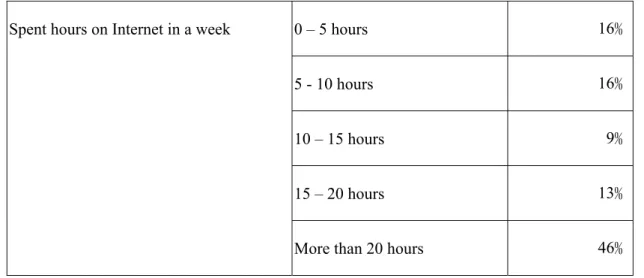Enhancing Interactivity in Web-based Instruction in Accordance with Institute of Technology Students’ Satisfaction Reaction toward E-Learning
全文
(2) Introduction and theoretical frameworks The quest for interactivity has become a necessary goal in the “design and provision” of distance education programs (Oliver & Mcloughlin, 1996).. Advanced technology can be. used to enhance communication and overcome the isolation of distance (Flottemesch, 2000). Oliver and McCloughlin (1996) further mentioned that in the context of distance education, “any learning material or learning environment is usually said to be interactive.”. Berge. (1999) provides a broader description of interaction in a distance setting: “Interacting is two-way communication among two or more people within a learning context, with the purposes either task/instructional completion or social relationship-building, that includes a means for teacher and learner to receive feedback and for adaptation to occur based upon information and activities with which the participants are engaged.” A valuable point from which to view issues related to distance education is to recognize the parts from which it is composed (Murphy and Terry, 1995).. Gamble and Gamble (1989). proposed a model for any type of communication containing 4 different parts (see Figure 1): (a). Sender - or source of information, the sender can be a person, group of people, or an entire institution.. (b). Message - the information need to be communicated.. (c). Channel – or method by which the message is communicated.. (d). Receiver – the person, persons, or institution to which the message is targeted.. 2.
(3) However, there should have a crucial component of “feedback” to represent the interaction between senders and receivers. These five components are important in evaluating the potential success of E-learning web education efforts for relative educational programs.. Overall, distance education research has focused primarily on the two former. factors with more limited evaluation of the latter two.. Sender. Message. Channel. Receiver. Feedback Figure 1.. Modified Gamble and Gamble (1990) model. Web-based training (WBT) is here to stay.. Many companies that once viewed WBT as. a fad are now quick to offer online training programs due to the savings, flexibility, and interactivity that these courses often provide (Powell, 2000). For whatever reason, the use of WBT is steadily increasing.. The popularity of WBT is growing at such a high rate that. about 500 products are now on the market for online learning (Torode, 1999).. According to. McGee (1999), “technology-based training, including web-based solutions, will represent half of all training by the year 2002, up from 25% [in 1998].”. According to the Gartner Group,. by 2003, 40% of e-learning activities will be directed at customers (Fister, 2000).. 3.
(4) Training can be delivered using a complexity of media, such as the traditional classroom and computer-based training.. Choosing Internet technologies to deliver training should. occur only after careful consideration of a number of factors.. These factors include what is. taught, who is taught, where the teaching takes place, when the teaching takes place, and how the teaching is supported (Powell, 2000).. Table 1 was summarized Powell’s comments. about the factors to consider when deciding whether to used WBT. Table 1. Factors to consider when deciding whether to used Web-based training Who is Taught What is Taught Where the Teaching When the Teaching. How the Teaching is. Takes Place. Takes Place. Supported. Just-in-time. Administration. Anytime. Technical support. Frequency. Corporate support. Culture of the. Domain of. Technical. organization. learning. infrastructure. Size of the. Stability of. organization. content. Learner. Importance of. characteristics content consistency Number of. Content. Learners. complexity. Geographic. Media. Instructor support. Development. 4.
(5) dispersion of. complexity. support. learners Number of. Requirement. training sites. for special equipment. Consequence of Format of time off the job current materials Preferences of Confidentiality learners Development of interactive Web-based instruction (WBI) has been widely discussed and applied in instructional design (Berge, 1999; Gilbert & Moore, 1998, Khan, 1997; Sherry & Wilson, 1997; Starr, 1997; Liaw & Huang, 2000).. Instructional design for educational. purposes is the systematic design of teaching and learning environments.. This design may. include different methods and media, such as programmed instruction, direct instruction, self-instructional textbooks, computer-based training, and interactive multimedia.. Within. the context of K-12 or higher education, instructional designers are usually asked to implement WBI with a high quality of interactivity (Liaw & Huang, 2000).. Gilbert and. Moore (1998) once asked in regarding interactivity: “Do we have a clear idea that we are. 5.
(6) using these new features because they will allow us to use truly interactive and adaptive techniques that will enhance student learning?” (p.29). Purposes and Objectives The purpose of this study was to understand in deep about the faced hardness, level of acceptance, and satisfaction reaction for those students at Institute of Technology who were completed WBI courses and focus for the improvement of interactivity instruction in the future for WBI courses. 1.. The objectives, stated as questions, were:. What are some basic attitudes (understanding, usage, perception of resources, perception of effectiveness, proposed action, etc.) of surveyed Institute of Technology students toward WBI?. 2.. Are there difference in many aspects between WBI and traditional instructions?. 3.. What are some reasons for students did not like WBI?. 4.. What is the level of acceptance for students after WBI?. 5.. Are there really increase students’ learning interests (satisfaction) from WBI?. Methods and Procedures The population for the study was all Institute of Technology students.. The instrument. used to collect data was designed by a group of students who took “Internet” class of researcher.. After careful explanation about the “Internet Questionnaire” issue in the. 6.
(7) beginning of the class, this group will go on to collect information from literature, design the questionnaire, and upload the internet questionnaire which was designed by MS FrontPage 2000 to the free service academic web site GAIS searching engine ( http://gais.cs.ccu.edu.tw/ ) for a month period (from march 1, 2002 to April 4, 2002) survey, and then report the final results at the end of the class. study.. Besides that, they also make recommendations for future. The total response surveyed students are 64, since researcher told them do not. proceed to use E-mail to promote, because this research is trying to get initial idea about the response rate from voluntarily action.. Data were analyzed using SPSS 10.0 on PC.. Descriptive Statistics were calculated for each variable.. Responses and Percentages were. used to summarize agreement or disagreement with items about basic attitudes toward WBI, comparisons between WBI and traditional instruction, reasons not like WBI, level of likeness, level of acceptance, and level of satisfaction toward WBI.. Results The total response numbers for this study which was posted on GAIS searching engine (http://gais.cs.ccu.edu.tw/) are 64, in them had 89﹪people understood distance learning, and only 11% people did not recognize distance learning. Surveyed students used WBI is around 42%.. Concerning with the resources of WBI, the results shown that 74﹪did not think the. resources are plenty.. There is no significant distinguish between effect of WBI (54﹪) and. traditional instruction (46%), however, effect from WBI looks like tiny better than traditional. 7.
(8) instruction.. Students understood course contents was achieved high to 69%, and proposed. more questions under WBI than traditional classes, the agreed to not agreed percentage are 59% to 41%, respectively (Table 1). Table 1. Basic Attitudes of Surveyed Students toward WBI, and Comparisons Between WBI and Traditional Instructions Items. Response. Percentage. Yes. 89﹪. No. 11﹪. Yes. 42﹪. No. 58%. Yes. 26﹪. No. 74﹪. Yes. 54﹪. No. 46﹪. Yes. 69﹪. No. 31﹪. Proposed more questions under WBI than traditional. Yes. 59﹪. classes. No. 41﹪. Understanding distance learning. Used WBI instructions. Resources of WBI are very plenty. Effect of WBI is better than traditional instruction. Understanding course contents taught on WBI. Table 2 summarized the reasons for those students who were disliked WBI.. 8. The.
(9) highest percentage is “learned nothing” (40%), and followed by “too troublesome” (20%), “others” (20%), “too boring” (13%), “no facility for learning at home” (7%), and no taste for new stuff (0%). Table 2.. The Reasons For Students Who Were Disliked WBI. Items Reasons for dislike WBI. Response. Percentage. Too troublesome. 20﹪. Too boring. 13﹪. Learned nothing. 40﹪. No taste for new stuff. 0﹪. No facility for learning at home. 7﹪. Others. 20﹪. Concerning with the level of likeness toward WBI, the results shown no significant positive answer to that, because about 42% students gave “no” response, and 52% students did not care about the difference, and only 6% gave definite “yes” answer to support the notion that WBI is more favorable than traditional instruction. Table 3. Level Of Likeness Of Students Between WBI And Traditional Instruction Like WBI more than traditional. Yes. 6﹪. instruction. No. 42﹪. Did not care. 52﹪. In Table 4, surveyed students had expressed “no opinion” (64%) answer about the 9.
(10) satisfaction after WBI, and comparison between satisfaction and not satisfaction site are 19% to 17%, respectively.. The majority of the students held “mediocre” attitude.. Table 4. Level Of Satisfaction Of Students After WBI Satisfaction after WBI. 6﹪. Strongly Satisfaction Satisfaction. 13﹪. No opinion. 64﹪. Not satisfaction. 15﹪ 2﹪. Strongly not satisfaction First part of the Table 5 listed students spent hours on Internet within a week.. We can. clearly observe the most hour interval is “more than 20 hours” (40%), then followed by “0 – 5 hours” (16%), “5 – 10 hours” (16%), “15 - 20 hours” (13%), and “10 – 15 hours” (9%).. On. the second part, we can vividly observe that students spent most hour range on relative WBI website is “0 – 2 hours” (73%). Table 5. Students Spent Hours On Internet, And Their Activity Concerning With WBI Website Spent hours on Internet in a week. 0 – 5 hours. 16﹪. 5 - 10 hours. 16﹪. 10 – 15 hours. 9﹪. 15 – 20 hours. 13﹪. More than 20 hours. 46﹪. 10.
(11) Spent hours on WBI website in a week. 0 – 2 hours. 73﹪. 2 – 4 hours. 9﹪. 4 – 6 hours. 9﹪. More than 6 hours. 9﹪. Conclusions and Recommendations Conclusions From the results, 89% of 64 surveyed students who can recognize what is the distance learning? but only 42% of them used WBI.. We can separate as two groups to further. conclude the study: 1.. Used WBI students Twenty-seven out of 64 students (42%) had experience with distance learning, that explained the situation about the extension of distance education still needs to put more effort on it, and 74% students felt resources of WBI is less than traditional instruction, and that information still needs to go on further examination.. Around. 45% students considered the learning effect of WBI was better than traditional instruction, and this result can explain in the situation of traditional instruction, the way of address by the instructor is more uniform, it is hard to make students to pay attention on it in the long run, students will have a lot of doubts on their mind if they lost their concentration.. If the contents put on the Internet, students can preview and. 11.
(12) review any time according to their own paces, even they can download the contents for study benefit, under this situation, they not only had the benefit of not facing the drawbacks in traditional class, but also had the benefit of flexibility on learning. The result shown 69% students understood course contents taught on WBI.. Another. finding is a major improvement for Asian student, there is about 59% students are brave to proposed more questions to teachers than traditional classes, because most of students are very quiet in the traditional classes, though had a lot of questions in mind, but they don’t have guts to spit out the questions that they really want to know. Although most of students (64%) gave a “mediocre” answer toward satisfaction after WBI, but the result still give the positive sign in the future, because the score is more than average number 3. 2.. Students did not have experience to use WBI There are 37 students did not use distance learning.. Around 40% students. expressed learned nothing from WBI, and followed by too troublesome, too boring, etc.. As further investigation, we can see those people did not have experience on. WBI, so they will express “learned nothing” attitude toward WBI, if someone can spent time to explain the advantages of WBI, or the way to use WBI, maybe they can change their negative attitude into positive site. The results shown that spent hours on Internet weekly more than 15 hours is 59%,. 12.
(13) however, most students only spent 0 - 2 hours on WBI website. As a whole, most students think three major reasons caused them dislike traditional instruction: (a) they could not fully understand what are they listened on class, (b) not easy to concentrate, and (c) easy to take a nap.. Students think the advantages for traditional class is. get more quick response from teacher, and high interaction than WBI.. The advantages of. WBI can be classified as repeatedly learning to improve acquisition, learning by their own paces, and flexibility on time. Recommendations In according to above conclusions, we also can make two sites of recommendations, one site for the teachers, and the other site for the students. 1.. The most major reason for teachers did not used the WBI maybe they think it was too troublesome, because teachers need to spend extra hours on the preparation of teaching materials.. Not only because about the preparation, bust something also. concerning with the execution, such as upload or sometimes download the materials into Internet or own computers, and sometimes teachers will spent some extra money about the preparation of teaching materials for their assistants.. On the. other hand, funding and administrative supports from school also played very major reasons for teachers to go on WBI. 2.. As students, the WBI is worthy when they really want to learn something.. 13.
(14) Especially WBI in Taiwan still plays an computer-aid instruction role, as an instructor, we need to very careful to examine the addressed contents, interactivity, and quick responses from students, because in any form of teaching and learning environment, teachers hold the key, and lead the students into the door to get the right thing that they need.. Maybe in the future, the trend will be focused on the. united WBI and traditional instruction.. References Berge, Z. L.. (1999).. Interaction in postsecondary web-based learning.. Educational. Technology, 39 (1), 5-11. Fister, S.. (2002).. At your service.. Inside Technology Training Online;. http://www.trainingsupersite.com/ittrain/feature2.htm Flottemesch, K.. (2000).. review of the literature.. Building effective interaction in distance education: A. Educational Technology 40 (3), 46-51.. Gamble, M. W. & Gamble, T. K. second edition.. Introduction to mass communications,. New York: McGraw-Hill.. Gilbert, L., & Moore, D. R.. (1998).. for social and instructional interaction. Khan, B. H.. (1989).. (Ed.).. (1997).. Building interactivity into Web courses: Tools. Educational Technology, 38 (3), 29-35.. Web-based Instruction.. Educational Technology Publications.. 14. Englewood Cliffs:.
(15) Liaw, S. S., & Huang, H-M.. (2000).. Educational Technology, 40 (3), 41-45.. instruction: A review of the literature. McGee, M.. (1999).. Enhancing interactivity in Web-based. ImformationWeek, 1718, 101-105.. Train on the Web.. Murphy, T., & Terry, R. Jr.. (1995).. Needs assessment of agricultural faculty. Proceedings of the 44th Annual Southern Agricultural. regarding distance education.. Education Research Meeting: Wilmington, NC. Oliver, R., & McLoughlin, C.. (1996).. interactions in live interactive television.. An investigation of the nature and form of. Learning technologies: Prospects and pathways.. Selected papers from EdTech’ 96 Biennial Conference of the Australian Society for Education Technology (Melbourn, Australia, July 7-10, 1996) [ERIC Database: ED 327169]. Powell, G. C.. (2000).. Are you ready for Web-Based Training? Educational. Technology, 40 (3), 52-55. Sherry, L., & Wilson, B. web innovations.. In B. H.. (1997).. Transformative communication as a stimulus to. Khan (Ed.), Web-based instruction (pp. 67-73).. Englewood. Cliffs: Educational Technology Publications. Starr, R. M.. (1997).. basic design principles. Torode, C. News, No. 833,. Delivering instruction on the World Wide Web: Overview and. Educational Technology, 37 (3), 7-14.. (1999).. More band for the buck in Internet training.. 199, 196.. 15. Computer Reseller.
(16)
數據
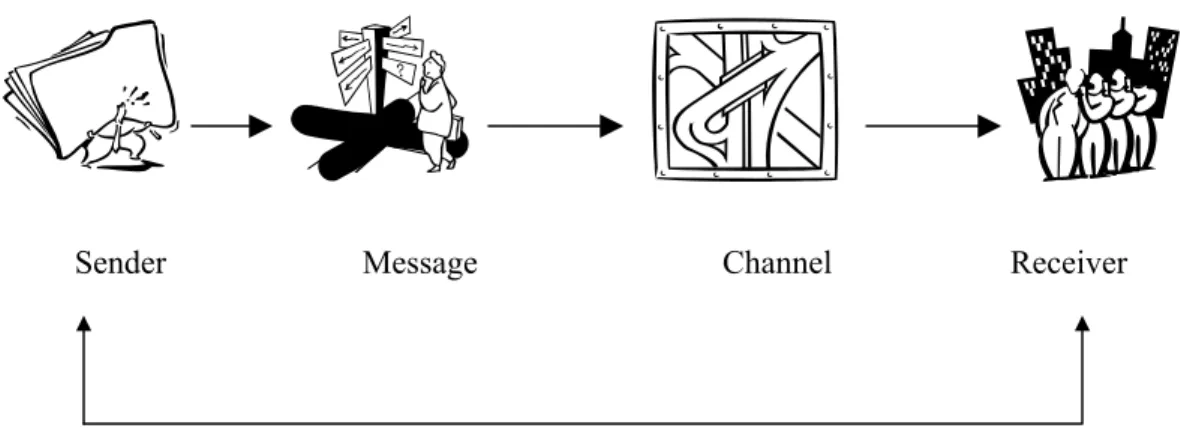
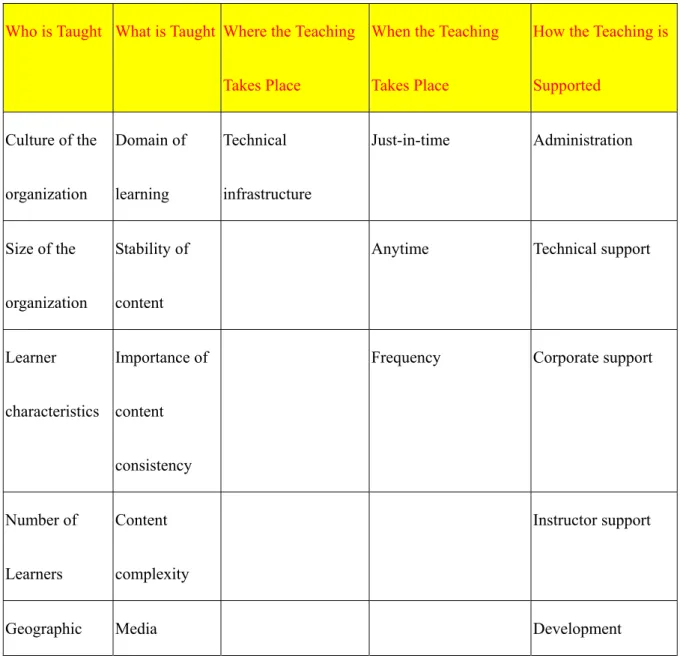
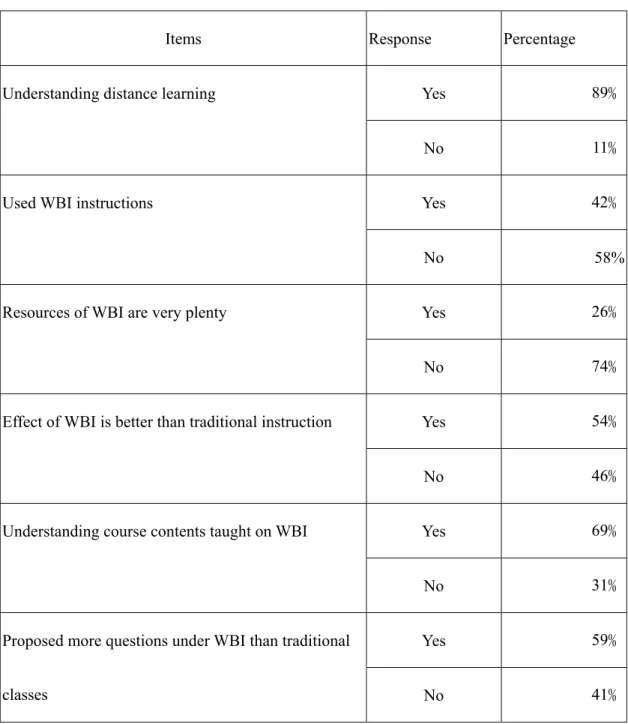
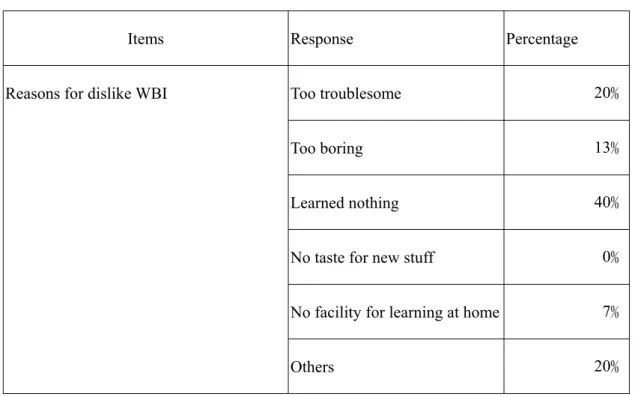
相關文件
An electronic textbook is a comprehensive and self-contained curriculum package with digital print-on demand contents and electronic features (e-features include multimedia
Consequently, Technology Education is characterized by learning activities which provide students with authentic experiences in various technological areas such as
Thus, our future instruction may take advantages from both the Web-based instruction and the traditional way.. Keywords:Traditional Instruction、Web-based Instruction、Teaching media
Web-based Learning Courses for Gifted/More Able Students (jointly administered by EDB and
• To consider the purpose of the task-based approach and the inductive approach in the learning and teaching of grammar at the secondary level.. • To take part in demonstrations
• Learn strategies to answer different types of questions.. • Manage the use of time
• developing coherent short-term and long-term school development plan that aligns the school aims, the needs, interests and abilities of students in accordance with the
training in goal setting (from general to specific) Task 2: Let’s help our students set better goals with reference to the HKDSE writing marking
